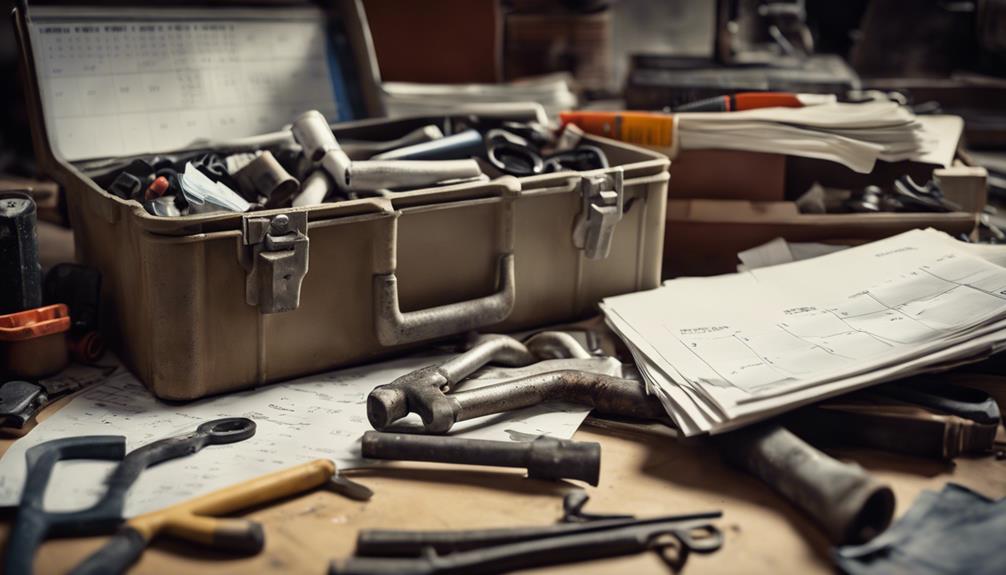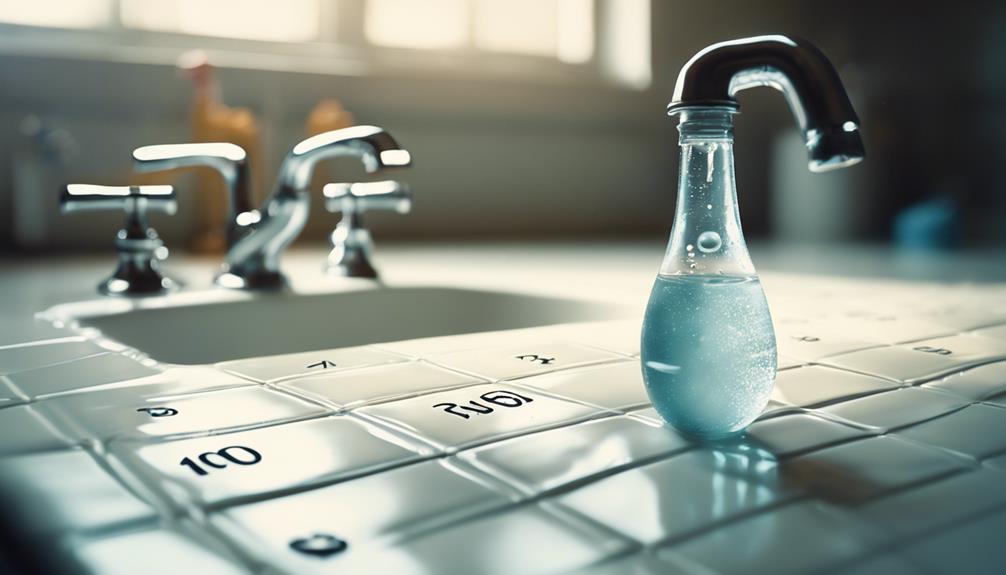You need a structured water maintenance schedule to guarantee your system operates efficiently and safely. Start by creating a tailored schedule that addresses your system's unique needs and facility requirements. Outline regular maintenance tasks, frequencies, and responsible personnel. Review user manuals and manufacturer guidelines to stay updated on recommended procedures. Consider factors like system usage, local regulations, and seasonal changes. Establish a routine schedule to prevent costly repairs and downtime. Schedule regular servicing appointments to identify potential issues early on. By following these essential tips, you'll be well on your way to maintaining a healthy water system – and there's more to explore to optimize its performance.
Table of Contents
Key Takeaways
- Establish a routine maintenance schedule to prevent costly repairs and downtime, considering factors like system usage and local regulations.
- Review the system's user manual and manufacturer guidelines to stay updated on recommended maintenance procedures and frequencies.
- Monitor water quality regularly, checking clarity, chemical makeup, and parameter limits to identify potential issues early on.
- Inspect pipe conditions, flow rates, and joints regularly to detect signs of corrosion, damage, or wear, and take proactive steps to prevent damage.
- Keep a detailed record of all maintenance activities, including servicing appointments, repairs, and replacements, to track progress and identify areas for improvement.
Establish a Maintenance Schedule
To guarantee your water treatment system operates efficiently and effectively, create a tailored maintenance schedule that addresses the system's unique needs and your facility's specific requirements.
This schedule should outline regular maintenance tasks, frequencies, and responsible personnel to confirm proper upkeep. Don't forget to review the system's user manual and manufacturer guidelines to stay updated on recommended maintenance procedures.
For water well maintenance, consider factors like system usage, local regulations, and seasonal changes to certify your schedule is thorough.
By establishing a routine maintenance schedule, you'll prevent costly repairs and downtime by identifying potential issues before they escalate. Gather necessary tools and supplies, and notify relevant personnel about upcoming maintenance activities to confirm a smooth process.
With a well-planned schedule, you'll be able to maintain peak water quality, reduce the risk of system failures, and enjoy continuous operation.
Inspect and Test Water Quality
As you inspect and test your water quality, you'll need to assess its clarity and analyze the parameter limits.
You'll want to check the water's transparency, ensuring it's free from sediment and contaminants.
Next, you'll analyze the water's chemical makeup, verifying that parameters like pH, alkalinity, and hardness fall within acceptable ranges.
Water Clarity Check
Your water's clarity is a critical indicator of its overall health, and regular checks can help identify potential issues before they escalate into major problems.
By incorporating water clarity checks into your routine inspections, you can guarantee your water supply remains safe and healthy.
During these checks, you'll want to look for signs of cloudiness, sedimentation, or unusual odors.
If you notice any of these issues, you must perform water testing to determine the root cause.
Regular water testing can help prevent damage to your pipes, appliances, and fixtures, saving you from costly repairs down the line.
As part of your maintenance tasks, schedule water clarity checks at least once a month, or more frequently if you notice any changes in your water's appearance or taste.
Parameter Limits Analysis
You'll need to analyze parameter limits to guarantee your water quality meets established standards, building on the insights gained from regular water clarity checks.
This involves inspecting and testing your water quality to verify it's within acceptable levels.
Regular maintenance is vital to prevent contamination and confirm your water system is functioning correctly.
During parameter limits analysis, you'll need to test for various parameters such as pH, turbidity, and chlorine levels.
These tests will help you identify any deviations from the established standards, allowing you to take corrective action before issues arise.
Protect the Well Area and Cap

Protecting the well area and cap from potential sources of contamination is essential to maintaining a safe and healthy water supply. You must take proactive steps to prevent damage and secure your well cap. A damaged well cap can allow contaminants to enter your water system, posing a significant risk to your health.
Here are some key reasons why protecting your well area and cap is vital:
| Reason | Why It Matters |
|---|---|
| Prevents Contamination | Keeps your water supply safe from bacteria, viruses, and other contaminants |
| Reduces Maintenance | Helps prevent costly repairs and maintenance down the line |
| Maintains Water Quality | Safeguards the quality of your water, guaranteeing it's safe for drinking and use
Perform Routine System Checks
When performing routine system checks, you'll need to pay close attention to specific metrics to verify your water treatment system is functioning at its best.
You'll want to check water pressure to identify potential issues like clogs or leaks, inspect pipe conditions to detect signs of corrosion or damage, and monitor flow rates to guarantee the system is producing water at the desired rate.
Check Water Pressure
Checking water pressure is a crucial routine system check that helps identify potential issues before they escalate into costly problems or even health hazards. You should prioritize regular inspections to guarantee your water system is functioning at its best.
Monitor pressure: Keep an eye on your water levels and pressure gauges to detect any anomalies.
Check for low water pressure: Identify areas in your home where water flow is weak, as this could indicate a problem in your plumbing pipes.
Inspect your water heater: Verify your water heater is functioning correctly, as a faulty one can lead to water pressure issues.
Schedule regular maintenance: Set reminders for regular checks to prevent minor issues from becoming major problems.
Inspect Pipe Conditions
You'll need to visually inspect your pipes regularly to detect signs of corrosion, rust, or mineral buildup that can restrict water flow and lead to system failures.
Regular inspections are vital for proper maintenance, as they allow you to identify potential issues before they escalate into costly problems.
By inspecting your pipe conditions, you can prevent costly repairs and facilitate accurate diagnosis of any issues.
During your inspections, look for signs of damage such as cracks, leaks, or rust spots.
Check for mineral buildup, which can cause scaling and restrict water flow.
Also, inspect pipe joints and connections for any signs of wear or damage.
If you notice any issues, address them promptly to prevent further damage.
Monitor Flow Rates
Regularly tracking flow rates through routine system checks helps identify discrepancies in water pressure, flow velocity, and volume, allowing you to pinpoint potential issues before they impact your water supply.
This essential step in water maintenance confirms you're always on top of your system's performance.
By monitoring flow rates, you can:
Detect leaks and blockages: Identify unusual changes in flow rates that may indicate hidden leaks or blockages in your pipes.
Optimize water usage: Adjust your water usage habits based on your system's flow rates to prevent wastage and reduce your water bill.
Prevent corrosion: Identify areas where water flow is too slow, which can lead to corrosion and damage to your pipes.
Schedule maintenance: Plan regular maintenance checks based on your system's flow rates to prevent unexpected breakdowns.
Monitor Water Pressure and Flow

Maintaining a healthy water system requires monitoring water pressure and flow, as these two factors are essential in preventing damage to your plumbing fixtures, pipes, and appliances. By keeping an eye on these factors, you can identify potential issues before they become major problems, saving you from costly repairs and water damage.
| Issue | Cause | Effect |
|---|---|---|
| Low Water Pressure | Clogged pipes, corroded pipes, or faulty pressure regulators | Insufficient water supply, poor performance of appliances |
| High Water Pressure | Faulty pressure regulators, closed valves, or municipal supply issues | Damage to plumbing fixtures, pipes, and appliances |
| Low Water Flow | Leaks, clogs, or corrosion in pipes | Insufficient water supply, poor performance of appliances |
Regular inspections of your water pressure and flow rates can help you detect issues early on. Aim for a water pressure range of 40-80 PSI, with 60 PSI being the recommended standard for most homes. A flow rate of 4-6 gallons per minute is suitable for most households. By prioritizing preventive maintenance, you can guarantee your water system runs smoothly and efficiently, giving you peace of mind and protection from water damage and costly repairs.
Schedule Regular Servicing Appointments
To guarantee your water system continues to run smoothly and efficiently, scheduling regular servicing appointments with a licensed well contractor is vital to prevent costly repairs and health risks. By doing so, you'll confirm your well is running at its best, and your water is safe and healthy to drink.
Four essential reasons to schedule regular servicing appointments:
- Prevent Costly Repairs: Regular servicing appointments help identify and address potential issues early on, saving you from expensive repairs down the line.
- Maintain Energy Efficiency: A well-maintained well system guarantees maximum energy efficiency, reducing your energy bills and environmental impact.
- Improve Water Quality: Regular servicing appointments include thorough checks and cleaning to confirm your water quality is consistently high.
- Prolong Your Well's Lifespan: Regular inspections and maintenance help extend the lifespan of your well, saving you from costly replacements and confirming a steady supply of healthy water.
Keep Accurate Maintenance Records

You should keep a detailed record of all maintenance activities, including servicing appointments, repairs, and replacements, to guarantee you have a thorough history of your well's performance and maintenance.
This record will serve as a valuable resource, enabling you to track patterns, identify potential issues, and make informed decisions about future maintenance.
Proper maintenance records certify that your Water Treatment Systems operate at peak levels, providing you with clean and safe drinking water.
By keeping regular records, you'll be able to monitor your system's performance and make adjustments as needed.
This proactive approach will help prevent unexpected breakdowns, reduce repair costs, and extend the lifespan of your equipment.
Additionally, accurate records will provide a thorough overview of your system's maintenance history, allowing you to identify areas that require improvement and make data-driven decisions.
Frequently Asked Questions
How Do You Maintain a Well Water System?
You maintain a well water system by conducting regular well inspections, monitoring water quality, promoting aquifer recharge, optimizing pump efficiency, implementing corrosion control, performing bacteria testing, and cleaning filters to guarantee a safe and reliable water supply.
What Are the Maintenance Required to the Water System?
You'll need to perform regular Pipe Inspections, Water Testing, System Flushing, Filter Cleaning, Leak Detection, Valve Replacement, and Corrosion Control to keep your water system running smoothly and provide access to safe, clean drinking water.
How to Maintain a Tank Watering System?
You maintain a tank watering system by performing regular tank inspections, ensuring water quality through cleaning and sediment removal, controlling corrosion, preventing overflows, and applying tank coatings, all essential steps to prolong its lifespan.
What Is the Maintenance of Water Management?
You guarantee water management maintenance by monitoring water quality, optimizing system efficiency, conserving resources, and performing infrastructure upkeep to guarantee supply reliability, network optimization, and flood prevention, ultimately protecting public health and the environment.
(Alternative words used: guarantee instead of ensure)
Conclusion
By following these 7 essential tips, you've taken the first step towards safeguarding the lifeblood of your home – clean water.
Your proactive approach has erected a fortress against contamination, ensuring every sip is a rejuvenating oasis.
As you maintain your water system, imagine a shield of protection enveloping your loved ones, giving you peace of mind with each turn of the faucet.
Stay vigilant, and your water will remain a crystal-clear haven, nourishing your family for years to come.

